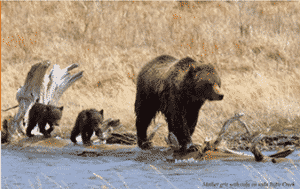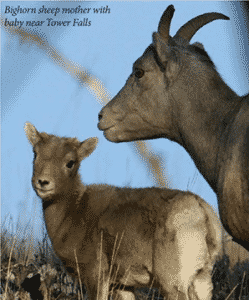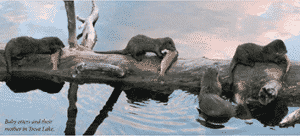Yellowstone Wildlife Viewing
Animal Introduction

Yellowstone’s animals are wild. People are injured and or killed by many different kinds of animals in the park each year. Please do not be one of them. The Park rules are to keep at least 100 yards from bears and 25 yards from other animals. While in Yellowstone, you will probably see things that you have never imagined. Speaking from experience, under these circumstances, you must be extra careful not to throw “caution to wind.” Or as the saying around here goes, “Don’t check your brain in at the Gate.”
That said, if you are in Yellowstone long enough, you are going to find yourself in a situation with some of Yellowstone’s wildlife that you would rather not be in. How you handle yourself will determine, to a great extent, whether you and/or the animal are harmed. Since every situation will be unique, there will be many different ways to handle the particular place and setting in which you find yourself. Try not to get into these positions but, if you find yourself in one, as a general rule, first survey your surroundings and then identify any hazards that will block your escape, i.e., other animals or terrain obstructions. Then slowly back away from the animal. In spring 2010, I was hiking backcountry in Yellowstone (just 1/8 mile off a paved road) and topped a small ridge to find a griz sow and small cub only 150ft in front of me. The sow saw me but did not act aggressively. Instead she was devoting her attention to turning over rocks and watching her one cub. I started to back up, retracing my steps, while keeping my eye on the griz. As I backed down the ridge, she lost sight of me and stood up on her hind legs to find out what I was doing. Thinking I did not want the griz to come looking for me, I took two steps back up to the ridge line so that she could keep me in view and know that I was not a threat to her and her cub. Then I walked slowly away from the bear along the ridge line. She went back to turning over rocks and I moved off to a safe distance. Another time I was near the Mammoth Hotel with some friends. We had just pulled up in their car but decided not to get out because of a love-crazed bull elk that was walking around the area trying to keep up with his scattered harem of cows. We knew that he was loved-crazed because it was fall mating time. There were many people outside their cars and a few rangers trying to control the situation. Suddenly, the elk turned to a car near him and rammed his horns into the car’s radiator. At that point, there was nothing the car could do; its radiator had a large hole in it. The elk had “killed” the car. Next the elk raced towards some of the people who were outside of their cars and trucks. One man did not have time to get to the door of his truck and had to dive into the bed of his pickup as the elk chased him. At this point, the elk walked away and the situation was defused. The next day as I was driving through Mammoth, I saw that same love-crazed elk minus his large antlers. The park rangers had carefully sawn them off. These are just some of the many situations you might find yourself in while in Yellowstone. Each circumstance requires different actions to defuse a perceived or real threat.
If you are serious about seeing grizzly bears, wolves and some of Yellowstone’s other wildlife, then you will want to have a spotting scope and binoculars with you. Many of your wildlife viewing opportunities will be 500 yards are more away. This is not necessarily a bad thing when viewing grizzly bears and wolves fighting over who sits at the dinner table first. Having a spotting scope will be the difference between seeing wolf pups roll about and play in front of the den or seeing three fuzzy specks in the far distance doing who knows what. You can rent both at The Silver Gate General Store, which I have owned and operated for 7 years, located conveniently near Yellowstone’s Lamar Valley, in Silver Gate, MT. You can also rent a camera for taking pictures through your scope (digiscoping) for once-in-a-lifetime photographs.
Animal Seasons in Yellowstone
The time of year that will, to a large degree, determine the setting and types of animals that you will see when you arrive in Yellowstone.

July and August is the time of year when many animals head for the high country. Elk and bear are a little less common in the valleys. Remaining herds of bison, at times, fill the valleys from end to end. For much of July, osprey nests will still hold this year’s hatchlings. Around the first week of August, bison will go into rut. This is the least talked about animal “cool thing” in the park. Male bison will butt heads with such force that sometimes one bull will go down during a battle never to get up again. The noise the rutting bulls make will seem other worldly or may remind you of your husband or boyfriend. Sad but true.
September and October is a magical time in Yellowstone. The elk start to rut around the first week in September and continue through much of the month. Fall colors can begin to show up in early September and usually peak around the 20th. Fall is the time of year to photograph elk, moose, bighorn, grizzly and just about every other Yellowstone animal in their prime. As the season progresses, the number of people and cars in the park drop off, allowing for a more intimate time.
November thru April is a great time to watch wolves. The elk tend to stay closer to the valley due to deep snow covering their food source at higher elevations. On many days, you can see wolves dining at their favorite restaurant, appropriately called “elk carcass”.
"Best" Animal Viewing Spots
Barronette Peak is a spectacular place to view mountain goats and bighorn sheep. The cliff face of Barronette Peak is a 3500 foot sheer drop covered with waterfalls, petrified wood, mountain goats and bighorn sheep. If Barronette Peak does not take your breath away, then you are probably either dead or Barronette Peak is covered in clouds. You will need a spotting scope. Did I tell you that you could rent one at the Silver Gate General Store?
Trout Lake is the place to watch trout spawn. This usually happens between June 10 and July 25.
Otters come to fish and magic happens. There is a half mile hike from the trailhead to the lake. See the hiking section for more details.
Lamar Valley is the place to see grizzlies or wolves. Cottonwood trees dot the valley floor as the Lamar River meanders along, while aspen trees hug the base of the forest where the mountain slopes meet the grasslands below. Gray wolves usually start to den in April near the valley. Grizzly moms and their cubs are often seen in the spring and fall and less frequently in the summer. Herds of bison numbering into the hundreds are commonly seen most of the year. During the bison rut, the mating period running from the last week in July to mid August, you will be treated to the strange and timeless guttural groans of the bison bulls. Herds of elk may be seen in the winter, spring and the fall.
During spring, summer and fall, pronghorn are usually somewhere to be seen in Lamar Valley. Pronghorn can reach speeds of 60 miles per hour and as far as land mammals are concerned, they are second only to the cheetah which can run over 70 miles per hour. However, pronghorns are the fastest land mammal in the world at long distances, maintaining speeds up to 45mph over a distance of five miles.
Osprey, bald eagle, bighorn sheep and mule deer are commonly seen in or near the valley. Badger, otter and beaver are always around somewhere and occasionally seen. There is no better place in the lower 48 States to view so many kinds of large animals at one time than in Lamar Valley. I Guarantee!
Tower Fall area is the place to see osprey. Osprey (also called the “water eagle”) like to build their very large nest atop rock pinnacles above the Yellowstone River. Osprey eat exclusively fish. There are a number of pull-offs along the road between the Calcite Springs viewpoint and the Tower Fall general store. These pull-offs offer some of the “best” viewing areas to see nesting osprey in the park. Bighorn sheep are sometimes seen at surprisingly close distances while viewing osprey nests. Be extremely careful in this area because of the steep drop off into the Yellowstone Canyon Narrows. Many people have died being careless around this river gorge. Yes, they fell into the gorge.
Floating Island Lake is the place to see birds. Sandhill cranes have nested here for at least the last four years (2008-11). They nest on a small island 3 x 5 ft long. As soon as the long-legged hatchlings are big enough to get to the mainland, the parents take the chicks to shore to feed during the day and return to the nest at night. Sandhills eat grasses, tubers, earthworms, small reptiles, and amphibians but not fish.
I have seen trumpeter swans, great blue herons, ruddy ducks, and yellow-headed blackbirds just to name a few around or on the lake.
The lake apparently got its name from mats of grass and reeds that separate from the bank and sometimes float out in the lake. Floating Island Lake is located about 2.5 miles west of Tower Junction and 1/8 mile to the east of Hellroaring trailhead. It is best to view the lake’s wildlife from the small pull-off next to the road. Also, during the spring and early summer, approaching the lake is not allowed in order to give the nesting birds a break from all of us wildlife watchers. Do you ever wonder if the animals are watching back? Happy watching!
Mammoth is the place for elk. During the fall rut, which starts in early September, the big bull elk will be strutting their stuff, bugling like there is no tomorrow (a dangerous time for visitors). The cow elk seem oblivious to the bulls’ antics. But come springtime, all the baby elk testify to the effectiveness of the bulls’ attempts to impress the cows.
Mount Everts is a good place to view bighorn sheep. I park at the first large pull-off after entering the North Entrance of Yellowstone, near Gardiner, Mt. I scan the north end of Mount Everts to the east which overlooks Gardiner. I almost always spot bighorn sheep from this pull-off. You may spot groups of bighorn sheep numbering into the high 20's. You will need a spotting scope to view the sheep from this pull-off. Many times you will find the bighorn sheep along this same road, about the midway point between Gardiner and Mammoth. The sheep come down from the mountain and drink from the cool waters of the Gardner River (spelled differently than the town of Gardiner).
Madison Junction is one of the great elk viewing places in Yellowstone. You don’t want to miss checking out the Madison area for elk. During the fall rut, it is always a possibility that you may see two dueling elk battling it out in some of the most beautiful river meadows in Yellowstone. Swans, eagle and osprey also frequent the Madison Junction area.
Hayden Valley is the second “best” place to see a grizzly bear in Yellowstone. There was a photo going around the internet a few years ago that showed 19 grizzly bears around a bison carcass at the same time. If you hike in the Hayden Valley, just as anywhere else in grizzly country, make sure that you stay aware of your surroundings and appreciate the risk associated with hiking here. In approximately 2008, an experienced professional photographer was hiking in Hayden Valley, only a mile or two from the road.
He had bear spray and was well aware of the risk. The photographer had been mauled by a grizzly in years past. The main thing that I recall about the mauling is that the photographer said he was unable to draw his bear spray because of the bear’s incredible speed. This is a common statement by mauling victims. As in most, but not all, bear maulings, the photographer survived, but with severe injuries. During the summer of 2011 two people were mauled and killed by grizzly bears in or near Hayden Valley. Neither were carrying bear spray.
To lower the odds of a bear attack while in Yellowstone, make noise while hiking, slowing down where visibility is low, like twisty trails, dense forests or over hilltops. This is especially true while hiking in the open sagebrush fields of Hayden Valley because grizzly bears dig for roots and tubers amongst the sagebrush. Pay attention to wind direction and strength. If it’s blowing towards you, it can muffle your sounds and lessen the bear’s ability to smell you. Stay aware of your surroundings.
Hike in groups of 4 or more people. Check for areas that are closed for hiking due to high bear activity. Wolves frequent Hayden and of course, bison roam there. Hayden Valley’s soil was originally formed or deposited by what used to be an extension of Yellowstone Lake back during the waning days of the last glaciation of Yellowstone. Yellowstone River flows out of Yellowstone Lake and through the Hayden Valley on its way to Yellowstone Falls and Canyon. Be sure to check out Fishing Bridge near the outlet of the Yellowstone River from Yellowstone Lake. There are usually very large fish hanging out under or near Fishing Bridge. No fishing allowed at Fishing Bridge! You will want a spotting scope for watching wildlife in Hayden Valley.

